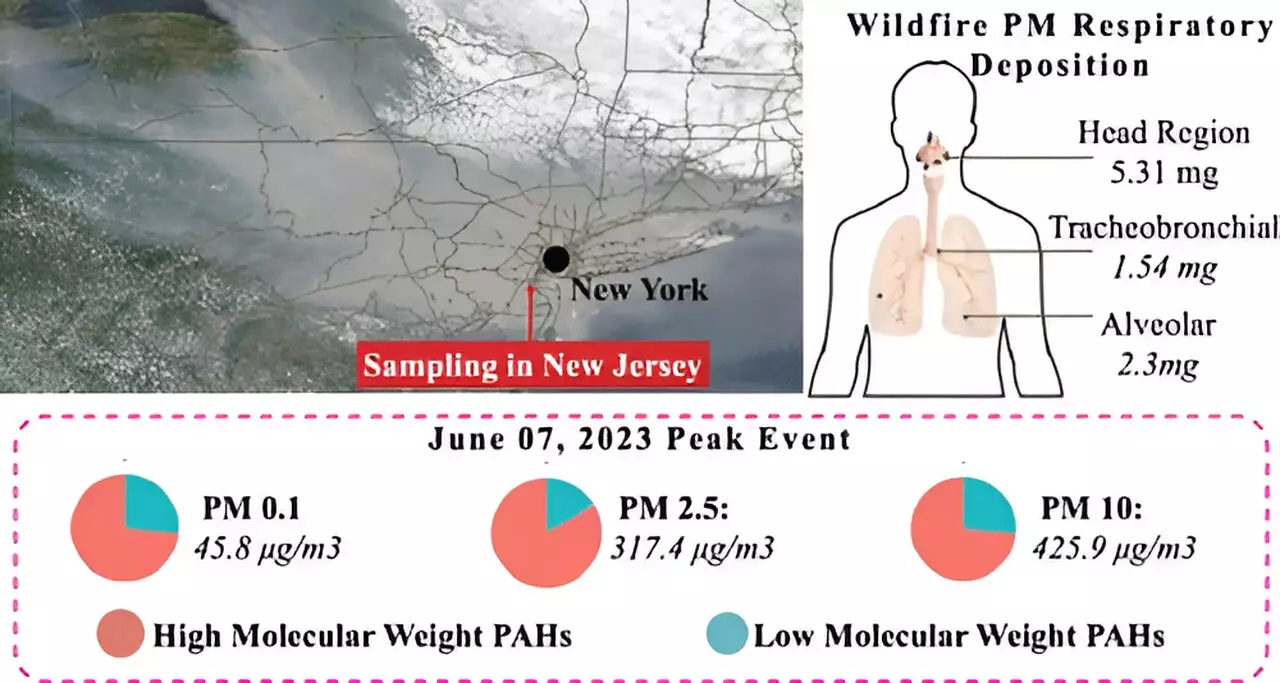Climate change is manifesting in increasingly catastrophic events, and one consequence that is becoming alarmingly evident is the rise of climate-driven wildfires. Researchers from Rutgers University have recently shed light on the dangers posed by particulate matter generated from these wildfires, particularly in densely populated areas like New Jersey and New York City. The study, published in the prestigious journal Environmental Science & Technology, examines the fallout from a significant wildfire event that occurred in June 2023, which triggered air quality advisories affecting over 100 million Americans. The research calls into question the fragile state of air quality in the region and highlights the urgent need to understand the implications of wildfire smoke on public health.
Particulate matter (PM) consists of tiny particles suspended in the air, which can have detrimental effects on human health. The research led by assistant professor Jose Guillermo “Memo” Cedeño Laurent indicates that this wildfire-related PM is not just a nuisance but a leading environmental health risk. According to the findings, climate-driven wildfires have the potential to reverse decades of progress made in improving air quality across the United States. With wildfires increasingly affecting air quality, Cedeño Laurent asserts that health risks associated with wildfire smoke are particularly severe, as emerging studies indicate that pollutants from these fires may lead to greater health challenges compared to those arising from conventional pollution sources.
The researchers utilized advanced analytic techniques to assess the composition of particulate matter linked to the June wildfire event. Their findings revealed significant levels of dangerous polycyclic aromatic hydrocarbons (PAHs), compounds known to cause cancer. Notably, particle concentrations were found to exceed federal air quality standards nearly tenfold during the peak of the wildfire event, marking a troubling milestone in air quality monitoring across the Northeast.
Cedeño Laurent emphasized the severe implications of these findings, stating that such high concentrations of ultrafine and fine particulate matter could penetrate deep into the lungs, leading to serious adverse health effects. This aligns with recent epidemiological studies indicating a spike in respiratory and cardiovascular emergencies in New York City coinciding with the wildfire event. The urgency of addressing these health impacts cannot be overstated—especially as scientists continue to grapple with the mechanisms driving these reactions in the body.
Further investigation into the health ramifications of inhaling wildfire smoke is ongoing. The study predicts that individuals exposed to such particulate matter during a 72-hour window could inhale more than 9 micrograms of PM10, raising concerns for vulnerable populations, including children and the elderly. The research team is collaborating with various medical experts to explore the diverse effects on critical organs, such as the lungs and heart, while extended studies aim to analyze effects on the brain and reproductive systems.
The partnerships between Rutgers researchers and institutions like Brigham and Women’s Hospital emphasize the interdisciplinary approach necessary to fully understand the complexities of this issue. As researchers work to map the impacts of wildfire smoke on health, they are also urging public health assessors to adapt their evaluation methods and risk assessment strategies so that communities can better prepare for these ongoing threats.
The emerging evidence surrounding wildfire smoke and particulate matter presents significant implications for public policy. As climate change intensifies wildfire events, there is a growing need to establish robust regulatory measures that ensure air quality safety. According to senior author Philip Demokritou, research findings can guide community leaders in devising effective strategies to mitigate risks associated with invasive wildfire pollution.
Furthermore, the study emphasizes the necessity for ongoing assessments of air quality and pollutant composition in real-time. As research continues, the insights from Rutgers’ work may inform urban planning and environmental regulations aimed at protecting public health in vulnerable regions.
In sum, the Rutgers study represents a critical step in illuminating the hidden dangers posed by particulate matter from wildfires. With climate change transforming the landscape of environmental health risks, it is imperative that scientists, health professionals, and policymakers work collaboratively to confront these challenges. Understanding the composition and health impacts of wildfire smoke is not just an academic exercise; it is a pressing public health concern that requires immediate action. As this research unfolds, increased awareness and proactive measures will be key in navigating the complexities of a rapidly changing climate and its effects on health and well-being.


Leave a Reply